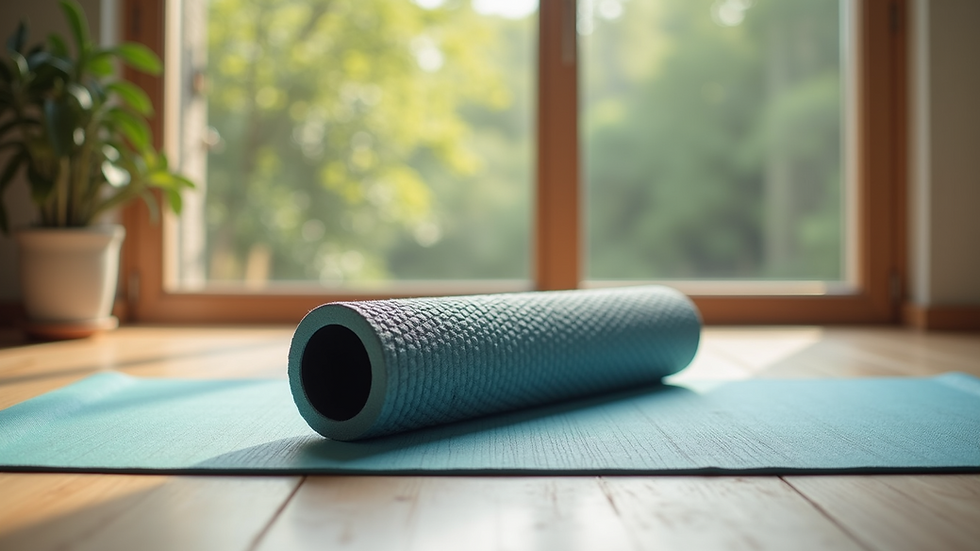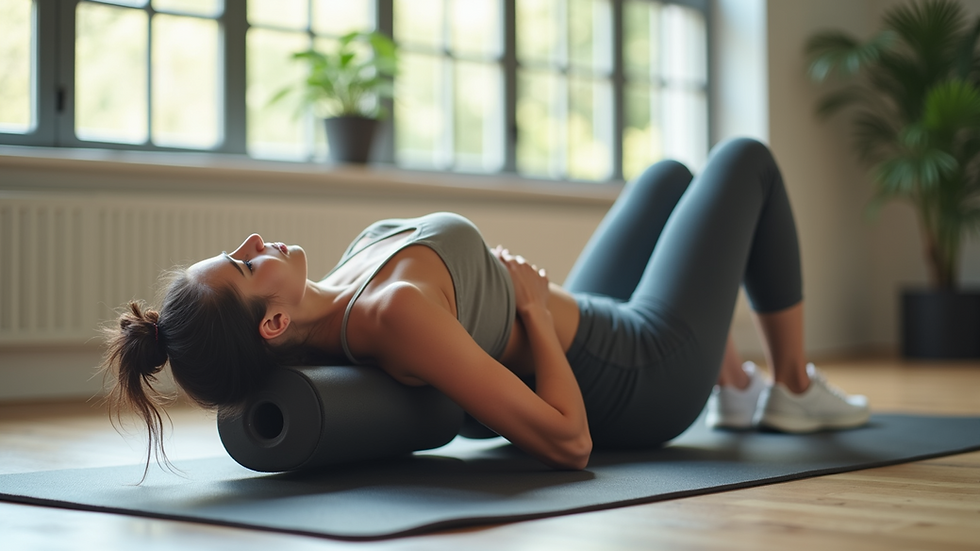FOAM ROLLING AND MYOFASCIAL RELEASE
- Moran Sciamama-Saghiv
- Aug 29
- 5 min read
Foam rolling and myofascial release are not just buzzwords. They have become essential tools for athletes and fitness enthusiasts of all levels who want to relieve muscle tension and improve recovery. Whether you hit the gym regularly, run marathons, or simply want to feel good in your body, these techniques can help. In this blog post, we will explore the benefits of foam rolling and myofascial release, effective methods for performing them, and practical tips for adding them to your routine.
Understanding Myofascial Release
Myofascial release is a hands-on technique aimed at relieving tension in the fascia—the connective tissue that wraps around your muscles, bones, and organs. Over time, factors such as injury, repetitive motions, and even stress can lead to tightness in the fascia. This restriction can cause pain and limit your range of motion. By using myofascial release techniques, you can effectively target these restrictions.
For instance, a study published by the Journal of Athletic Training found that incorporating myofascial release into a training routine could lead to a 20% increase in joint range of motion among athletes. Regular practice can significantly enhance mobility and overall performance.
The Role of Foam Rolling
Foam rolling is a self-treatment method that applies pressure to these tight areas. This pressure helps break up knots and adhesions in the fascia, promoting better blood flow and aiding recovery.
For those who work out, foam rolling can be especially beneficial. According to a study from the University of Kentucky, participants who engaged in foam rolling after workouts reported a 30% reduction in muscle soreness compared to those who did not. Including foam rolling in your routine can significantly improve your physical performance and lower your risk of injuries.
Benefits of Foam Rolling and Myofascial Release
1. Improved Flexibility
Foam rolling and myofascial release can enhance your flexibility significantly. By relieving tightness in your fascia, you can widen your range of motion. A study showed that regular foam rolling can improve flexibility by up to 10% over time. This can lead to better results in physical activities, whether it's weightlifting, running, or yoga.
2. Reduced Muscle Soreness
Feeling sore after an intense workout is common. Foam rolling can alleviate this discomfort by increasing blood flow to the muscles. In a survey by the American Council on Exercise, 95% of respondents reported reduced muscle soreness after consistent foam rolling practices. This is because better circulation helps clear waste products from muscle breakdown more efficiently.
3. Enhanced Recovery
Foam rolling and myofascial release can greatly improve your recovery times. By flushing out toxins and reducing inflammation, your body can heal faster. It is recommended to include these techniques in your post-workout routine for optimal recovery.
4. Pain Relief
Many people struggle with chronic pain due to tight fascia. Foam rolling can provide targeted relief by applying pressure to specific pain points. By focusing on areas like the lower back or hips, you can relieve tension that might otherwise lead to greater discomfort.
5. Improved Posture
Practicing foam rolling and myofascial release regularly can help correct postural issues. As tightness in fascia is released, your body can achieve better alignment. This is crucial for avoiding long-term problems that can stem from poor posture, such as back pain or discomfort in the neck and shoulders.
How to Foam Roll Effectively
1. Choose the Right Foam Roller
Choosing the right foam roller is essential. Foam rollers come in various types and densities. If you are new to rolling, start with a softer roller and gradually move to a firmer one as your body gets accustomed.
2. Identify Target Areas
Before rolling, take a moment to identify tight or sore spots in your body. Common areas to focus on are your calves, quadriceps, hamstrings, glutes, and upper back. Knowing where to roll can enhance your experience and effectiveness.
3. Use Proper Technique
To foam roll effectively, follow these steps:
Position Yourself: Sit or lie on the foam roller, placing it under the targeted muscle group.
Apply Pressure: Use your body weight to gently apply pressure. Roll slowly back and forth over the muscle.
Focus on Tender Spots: If you find a particularly tender spot, pause and hold for about 20-30 seconds. This allows the fascia time to release.
Breathe: Deep breathing can help you relax as you roll.
4. Duration and Frequency
Aim to spend 1-2 minutes on each target area. Integrate foam rolling into your routine 2-3 times per week, especially after workouts, to maximize benefits.
How to Perform Myofascial Release
1. Manual Techniques
While foam rolling is effective for self-myofascial release, sometimes, hands-on techniques from a trained therapist can be helpful. Techniques may include:
Trigger Point Therapy: This method applies pressure to specific muscle points to release tension.
Stretching with Pressure: Combining stretching exercises with manual pressure enhances the release of tight fascia.
2. Self-Myofascial Release Techniques
To perform myofascial release on your own at home, try these techniques:
Tennis Ball Release: Use a tennis ball against a wall or on the floor to target tension spots, such as your shoulders or hips.
Foam Roller Variations: Experiment with rolling on different body parts, like your side or using a smaller roller for pinpoint areas.
Tips for Incorporating Foam Rolling and Myofascial Release into Your Routine
1. Warm-Up First
A light warm-up before foam rolling is essential. Aim for 5-10 minutes of light aerobic activity to enhance blood flow and prepare your muscles.
2. Listen to Your Body
While rolling, be mindful of pain levels. Foam rolling shouldn't be excruciating. If you feel sharp pain, ease off the pressure or change your position. The goal is to relieve tension, not to create more discomfort.
3. Stay Consistent
Incorporate foam rolling and myofascial release into your fitness routine regularly. This consistency is crucial for maintaining flexibility and reducing muscle tension over time.
4. Combine with Stretching
After foam rolling, add some gentle stretching to your routine. This combo can further enhance your range of motion and promote muscle relaxation.
5. Hydrate
Post-rolling, ensure you drink plenty of water. Staying hydrated helps flush out toxins released during the process and encourages recovery.
Embracing Foam Rolling and Myofascial Release
Foam rolling and myofascial release are powerful techniques that boost not only physical performance but also your overall well-being. By integrating these practices into your fitness routine, you can recover faster, alleviate pain, and improve your flexibility. To maximize the benefits, choose the right tools, follow proper techniques, and always listen to your body as you explore the advantages of these practices. With regular practice and a little patience, you can unlock a new level of physical wellness.



Services by Dr. Moran Sciamama-Saghiv:





Comments